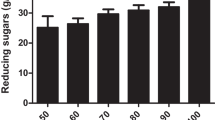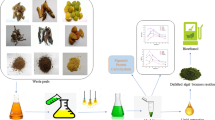Abstract
The aim of this study is to optimize the lipid accumulation in microalgae by using two agricultural residues of pineapple peels and sugarcane bagasse as low-cost organic carbon sources. Green microalgae Scenedesmus acutus was isolated and selected for cultivation. Effects of three initial sugar concentrations and the stage for adding sugar during cultivation on biomass and lipid production were investigated. The results clearly showed that two-stage cultivation is more suitable than one-stage. The maximum biomass concentration and productivity were obtained at 3.85 g/L and 160.42 mg/L/day when sugarcane bagasse was used. The highest lipid content and lipid yield was reached at 28.05 % and 0.93 g/L when pineapple peels were used, while in the case of sugarcane bagasse, 40.89 % and 1.24 g/L lipid content and yield were obtained. Lipid content was found in normal condition (autotrophic) at 17.71 % which was approximately 2.13-fold lower than when sugarcane bagasse was used (40.89 %). Biodiesel production via in situ transesterification was also investigated; the main fatty acids of palmitic acid and oleic acid were found. This work indicates that using agricultural residues as organic carbon sources could be able to increase lipid content and reduce the cost of biofuel production.




Similar content being viewed by others
Abbreviations
- S. acutus :
-
Scenedesmus acutus
- PP:
-
Pineapple peels
- SB:
-
Sugarcane bagasse
- Agro-residues:
-
Agricultural residues
- AC:
-
Autotrophic cultivation
- MC:
-
Mixotrophic cultivation
- μ:
-
Specific growth rate
- FAME:
-
Fatty acid methyl ester
References
Ahmad, A. L., Mat, Y. N. H., Derek, C. J. C., & Lim, J. K. (2011). Microalgae as a sustainable energy source for biodiesel production: a review. Renewable and Sustainable Energy Reviews, 15, 584–593.
Mata, T. M., Martins, A. A., & Caetano, N. S. (2010). Microalgae for biodiesel production and other applications. Renewable and Sustainable Energy Reviews, 14, 217–232.
Abou-Shanab, R. A. I., Hwang, J. H., Cho, Y., Min, B., & Jeon, B. H. (2011). Characterization of microalgal species isolated from fresh water bodies as a potential source for biodiesel production. Applied Energy, 88, 3300–3306.
Chisti, Y. (2007). Research review paper: biodiesel from microalgae. Biotechnology Advances, 25, 294–306.
Halim, R., Danquah, M. K., & Webley, P. A. (2012). Extraction of oil from microalgae for biodiesel production: a review. Biotechnology Advances, 30, 709–732.
Ho, S. H., Chen, W. M., & Chang, J. S. (2010). Scenedesmus obliquus CNW-N as a potential candidate for CO2 mitigation and biodiesel production. Bioresource Technology, 101, 8725–8730.
Kaewkannetra, P., Enmak, P., & Chiu, T. Y. (2012). The effect of CO2 and salinity on the cultivation of Scenedesmus obliquus for biodiesel production. Biotechnology and Bioprocess Engineering, 17, 591–597.
Arroyo, T. H., Wei, W., Ruan, R., & Hu, B. (2011). Mixotrophic cultivation of Chlorella vulgaris and its potential application for the oil accumulation from non-sugar materials. Biomass and Bioenergy, 35, 2245–2253.
Miao, X. L., & Wu, Q. Y. (2006). Biodiesel production from heterotrophic microalgal oil. Bioresource Technology, 97, 841–846.
Yan, D., Lu, Y., Chen, Y. F., & Wu, Q. (2011). Waste molasses alone displaces glucose-based medium for microalgal fermentation towards cost-saving biodiesel production. Bioresource Technology, 102, 6487–6493.
Lu, Y., Zhai, Y., Liu, M., & Wu, Q. (2010). Biodiesel production from algal oil using cassava (Manihot esculenta Crantz) as feedstock. Journal of Applied Phycology, 22, 573–578.
Gao, C., Zhai, Y., Ding, Y., & Wu, Q. (2010). Application of sweet sorghum for biodiesel production by heterotrophic microalga Chlorella protothecoides. Applied Energy, 87, 756–761.
Hu, B., Min, M., Zhou, W., Li, Y., Mohr, M., Cheng, Y., Lei, H., Liu, Y., Lin, X., Chen, P., & Ruan, R. (2012). Influence of exogenous CO2 on biomass and lipid accumulation of microalgae Auxenochlorella protothecoides cultivated in concentrated municipal wastewater. Applied Biochemistry and Biotechnology, 166, 1661–1673.
FAO, (2010). Statistical Yearbook. Food and Agriculture Organization of the United Nations. Available from: www.fao.org. Accessed November 26, 2013.
Ketnawa, S., Chaiwut, P., & Rawdkuen, S. (2012). Pineapple wastes: a potential source for bromelain extraction. Food and Bioproducts Processing, 90, 385–391.
Namsree, P., Suvajittanont, W., Puttanlek, C., Uttapap, D., & Rungsardthong, V. (2012). Anaerobic digestion of pineapple pulp and peel in a plug-flow reactor. Journal of Environmental Management, 110, 40–47.
Hu, X., Hu, K., Zeng, L., Zhao, M., & Huang, H. (2010). Hydrogels prepared from pineapple peel cellulose using ionic liquid and their characterization and primary sodium salicylate release study. Carbohydrate Polymers, 82, 62–68.
FAO, (2012). Impact of Thai sugar policy on the world sugar economy. Food and Agriculture Organization of the United Nations. Available from: www.fao.org. Accessed November 26, 2013.
Cardona, C. A., Quintero, J. A., & Paz, I. C. (2010). Production of bioethanol from sugarcane bagasse: status and perspectives. Bioresource Technology, 101, 4754–4766.
Inyang, M., Gao, B., Pullammanappallil, P., Ding, W., & Zimmerman, A. R. (2010). Biochar from anaerobically digested sugarcane bagasse. Bioresource Technology, 101, 8868–8872.
Gamez, S., Gonzalez-Cabriales, J. J., Ramirez, J. A., Garrote, G., & Vazquez, M. (2006). Study of the hydrolysis of sugar cane bagasse using phosphoric acid. Journal of Food Engineering, 74, 78–88.
Chandel, A. K., Kapoor, R., Singh, A., & Kuhad, R. C. (2007). Detoxification of sugarcane bagasse hydrolysate improves ethanol production by Candida shehatae NCIM 3501. Bioresource Technology, 98, 1947–1950.
Manikkandan, T. R., Dhanasekar, R., & Thirumavalavan, K. (2009). Microbial production of hydrogen from sugarcane bagasse using Bacillus Sp. International Journal of ChemTech Research, 1, 344–348.
Lohrey, C., & Kochergin, V. (2012). Biodiesel production from microalgae: co-location with sugar mills. Bioresource Technology, 108, 76–82.
Barsanti, L., & Gualtieri, P. (2006). Algae: anatomy, biochemistry and biotechnology. USA.: CRC Press.
Zhou, W., Li, Y., Min, M., Hu, B., Chen, P., & Ruan, R. (2011). Local bioprospecting for high-lipid producing microalgal strains to be grown on concentrated municipal wastewater for biofuel production. Bioresource Technology, 102, 6909–6919.
Balasubramanian, S., Allen, J. D., Kanitkar, A., & Boldor, D. (2011). Oil extraction from Scenedesmus obliquus using a continuous microwave system—design, optimization, and quality characterization. Bioresource Technology, 102, 3396–3403.
Ho, S., Chen, H. C. Y., & Chang, J. S. (2012). Effect of light intensity and nitrogen starvation on CO2 fixation and lipid/carbohydrate production of an indigenous microalga Scenedesmus obliquus CNW-N. Bioresource Technology, 113, 224–252.
Wang, Y., Chen, T., & Qin, S. (2012). Heterotrophic cultivation of Chlorella kessleri for fatty acids production by carbon and nitrogen supplements. Biomass and Bioenergy, 47, 402–409.
Da Silva, T. L., Reis, A., Medeiros, R., Oliveira, A. C., & Gouveia, L. (2009). Oil production towards biofuel from autotrophic microalgae semicontinuous cultivations monitorized by flow cytometry. Applied Biochemistry and Biotechnology, 159, 568–578.
Zhang, H., Wang, W., Li, Y., Yang, W., & Shen, G. (2011). Mixotrophic cultivation of Botryococcus braunii. Biomass and Bioenergy, 35, 1710–1715.
Doria, E., Longoni, P., Scibilia, L., Iazzi, N., Cella, R., & Nielsen, E. (2012). Isolation and characterization of a Scenedesmus acutus strain to be used for bioremediation of urban wastewater. Journal of Applied Phycology, 24, 375–383.
Torricelli, E., Gessica, G., Pawlik-Skowronska, B., Di Toppi, L. S., & Corradi, M. G. (2004). Cadmium tolerance, cysteine and thiol peptide levels in wild type and chromium-tolerant strains of Scenedesmus acutus (Chlorophyceae). Aquatic Toxicology, 68, 315–323.
Sacristan de Alva, M., Luna-Pabello, V. M., Cadena, E., & Ortiz, E. (2013). Green microalga Scenedesmus acutus grown on municipal wastewater to couple nutrient removal with lipid accumulation for biodiesel production. Bioresource Technology, 146, 744–748.
Knothe, G. (2008). Designer biodiesel: optimizing fatty ester composition to improve fuel properties. Energy and Fuels, 22, 1358–1364.
Acknowledgments
The authors would like to sincerely acknowledge the National Research University (NRU) Project, Khon Kaen University, Khon Kaen 40002, Thailand, for financial contribution under contract project number Ph.D 54302 for the year 2011–2014. In addition, one of the authors (P. Kaewkannetra) also would like to thanks Centre for Alternative Energy Research and Development (AERD), Faculty of Engineering, Khon Kaen University, Khon Kaen, Thailand for some matching fund (contract no. R06/56).
Author information
Authors and Affiliations
Corresponding author
Rights and permissions
About this article
Cite this article
Rattanapoltee, P., Kaewkannetra, P. Utilization of Agricultural Residues of Pineapple Peels and Sugarcane Bagasse as Cost-Saving Raw Materials in Scenedesmus acutus for Lipid Accumulation and Biodiesel Production. Appl Biochem Biotechnol 173, 1495–1510 (2014). https://doi.org/10.1007/s12010-014-0949-4
Received:
Accepted:
Published:
Issue Date:
DOI: https://doi.org/10.1007/s12010-014-0949-4




